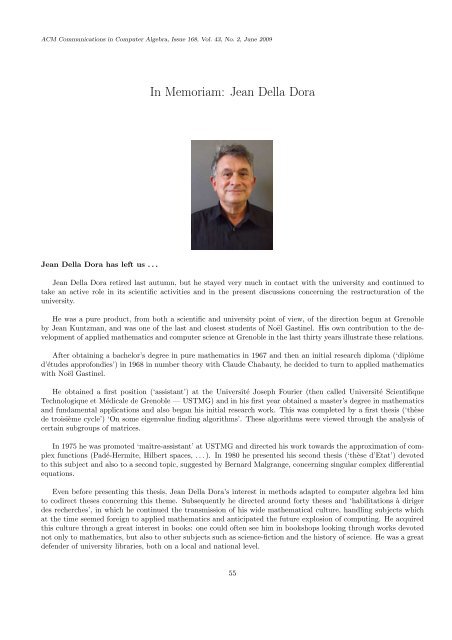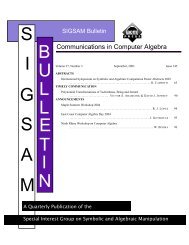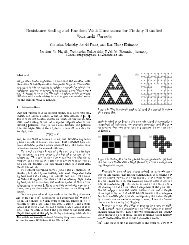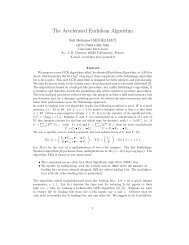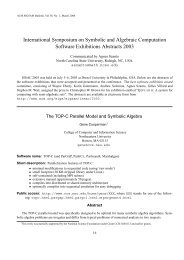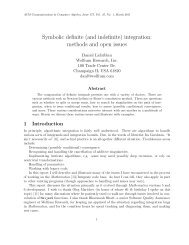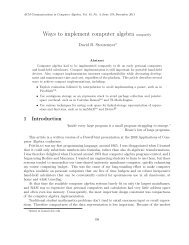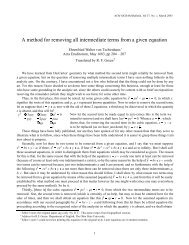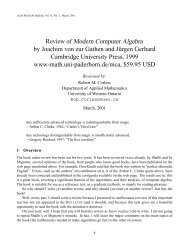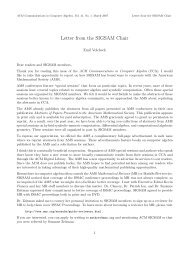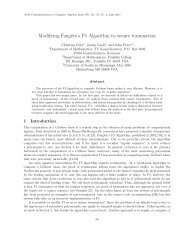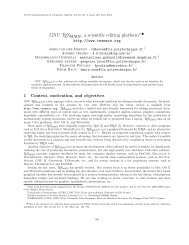In Memoriam: Jean Della Dora - SIGSAM
In Memoriam: Jean Della Dora - SIGSAM
In Memoriam: Jean Della Dora - SIGSAM
Create successful ePaper yourself
Turn your PDF publications into a flip-book with our unique Google optimized e-Paper software.
ACM Communications in Computer Algebra, Issue 168, Vol. 43, No. 2, June 2009<br />
<strong>In</strong> <strong>Memoriam</strong>: <strong>Jean</strong> <strong>Della</strong> <strong>Dora</strong><br />
<strong>Jean</strong> <strong>Della</strong> <strong>Dora</strong> has left us . . .<br />
<strong>Jean</strong> <strong>Della</strong> <strong>Dora</strong> retired last autumn, but he stayed very much in contact with the university and continued to<br />
take an active role in its scientific activities and in the present discussions concerning the restructuration of the<br />
university.<br />
He was a pure product, from both a scientific and university point of view, of the direction begun at Grenoble<br />
by <strong>Jean</strong> Kuntzman, and was one of the last and closest students of Noël Gastinel. His own contribution to the development<br />
of applied mathematics and computer science at Grenoble in the last thirty years illustrate these relations.<br />
After obtaining a bachelor’s degree in pure mathematics in 1967 and then an initial research diploma (‘diplôme<br />
d’études approfondies’) in 1968 in number theory with Claude Chabauty, he decided to turn to applied mathematics<br />
with Noël Gastinel.<br />
He obtained a first position (‘assistant’) at the Université Joseph Fourier (then called Université Scientifique<br />
Technologique et Médicale de Grenoble — USTMG) and in his first year obtained a master’s degree in mathematics<br />
and fundamental applications and also began his initial research work. This was completed by a first thesis (‘thèse<br />
de troisième cycle’) ‘On some eigenvalue finding algorithms’. These algorithms were viewed through the analysis of<br />
certain subgroups of matrices.<br />
<strong>In</strong> 1975 he was promoted ‘maître-assistant’ at USTMG and directed his work towards the approximation of complex<br />
functions (Padé-Hermite, Hilbert spaces, . . . ). <strong>In</strong> 1980 he presented his second thesis (‘thèse d’Etat’) devoted<br />
to this subject and also to a second topic, suggested by Bernard Malgrange, concerning singular complex differential<br />
equations.<br />
Even before presenting this thesis, <strong>Jean</strong> <strong>Della</strong> <strong>Dora</strong>’s interest in methods adapted to computer algebra led him<br />
to codirect theses concerning this theme. Subsequently he directed around forty theses and ‘habilitations à diriger<br />
des recherches’, in which he continued the transmission of his wide mathematical culture, handling subjects which<br />
at the time seemed foreign to applied mathematics and anticipated the future explosion of computing. He acquired<br />
this culture through a great interest in books: one could often see him in bookshops looking through works devoted<br />
not only to mathematics, but also to other subjects such as science-fiction and the history of science. He was a great<br />
defender of university libraries, both on a local and national level.<br />
55
<strong>Jean</strong> <strong>Della</strong> <strong>Dora</strong><br />
<strong>In</strong> 1980, when <strong>Jean</strong> Kuntzman left the position of director of LA 7 (Laboratoire Associé no. 7 CNRS) and<br />
the laboratory was at its beginning, <strong>Jean</strong> <strong>Della</strong> <strong>Dora</strong> took over the responsibility of the numerical analysis team.<br />
Up to this time, numerical analysts carefully avoided contact with large computers (and this, despite the incessant<br />
encouragements of Noël Gastinel). With the arrival of personal computers, <strong>Jean</strong> <strong>Della</strong> <strong>Dora</strong> enabled the team to<br />
obtain an IBM and then some Micrals and encouraged team members to consider the pleasures of programming. He<br />
also encouraged and took part in interdisciplinary work groups which were developing at the time (automata theory,<br />
control and automatics, spin glasses, . . . )<br />
The rounds of restructuring (deconcentration and reconcentration) of laboratories, federations and so on were<br />
beginning. The first of these resulted in 1983 in the separation of the IMAG (<strong>In</strong>stitut de Mathématiques Appliquées<br />
de Grenoble) into five laboratories and the creation of the new laboratory TIM3, in which <strong>Jean</strong> <strong>Della</strong> <strong>Dora</strong> took<br />
an active part. He brought together workers in various fields: biology, medical science, circuit architecture, functional<br />
security, numerical analysis, probability and statistics. Although still ‘maître-assistant’ (up till 1985, when he<br />
became professor at the <strong>In</strong>stitut Polytechnique de Grenoble — INPG), he was the natural choice for director of TIM3.<br />
<strong>In</strong> a political context favorable to the development of new ideas in universities, <strong>Jean</strong> <strong>Della</strong> <strong>Della</strong> helped members<br />
of the laboratory (finance, working conditions, . . . ) in the development of their individual projects (parallelism —<br />
Michel Cosnard, medical computer science and modelling — Jacques Demongeot, . . . ). <strong>In</strong> a way similar to that of<br />
Noël Gastinel (who left us in 1984), <strong>Jean</strong> saw himself modestly (sometimes too modestly) as an architect of ideas,<br />
always helping in the realization of projects, without taking into account time and energy, and always with humor<br />
and enthusiasm.<br />
The meetings at the laboratory were always lively, although sometimes a little strained, being concerned with scientific<br />
content and the development of projects. <strong>Jean</strong> was not particularly concerned with administrative questions,<br />
but always respected those who had the responsibility for them. This activity at the laboratory led to its division<br />
into three parts: Laboratoire de Modélisation et Calcul — LMC, Laboratoire TIMC et Laboratoire d’<strong>In</strong>formatique<br />
de l’Ecole Normale Supérieure de Lyon.<br />
<strong>Jean</strong> <strong>Della</strong> <strong>Dora</strong> left the position of director of the laboratory in 1991, but up till the end of his career, he was very<br />
active in his research group. He also continued to play an important role in the scientific activities of the <strong>In</strong>stitut de<br />
Mathématiques Appliquées de Grenoble — IMAG, in the university calculation center (1991-96) and at the INPG.<br />
He gave particular importance to the exchange of ideas, being convinced that a research worker must be free and<br />
not always under the eye of a director or scientific advisor.<br />
From 1980 onwards, <strong>Jean</strong> <strong>Della</strong> <strong>Dora</strong> became particularly interested in computer algebra and took part in its<br />
development at Grenoble, in France (GRECO Computer Algebra), and internationally (CATHODE, CADE). Several<br />
fields were and continue to be studied: the arithmetic of algebraic numbers, linear algebra, linear and non-linear differential<br />
equations, difference equations, algebraic equations. The study of algebraic numbers led to the D5 paradigm,<br />
named after <strong>Jean</strong> and his colleagues Dominique Duval and Claire Dicrescenzo, in which tedious computations and<br />
case splits are deferred until they become easier, or are never needed. <strong>Jean</strong> also explored parallel computer algebra<br />
and helped in the creation by his students of the first computer algebra system (PAC) to work on a parallel machine.<br />
At the beginning this research was conducted in collaboration with the U. Louis Pasteur in Strasbourg (<strong>Jean</strong>-<br />
Pierre Ramis) and the U. Libre de Bruxelles (Léon Brenig), then this collaboration was extended on the international<br />
level: European project CATHODE (with two ‘work groups’), project CADE with the USA, Canadian collaboration<br />
(Stephen Watt), research relations with Morocco. <strong>Jean</strong> played a major role in the research community of computer<br />
algebra and differential equations. He was very innovative in directions of research, in particular in his comprehension<br />
and vision of computer algebra.<br />
His work and interest in exact linear algebra and computing and his legendary curiosity enabled <strong>Jean</strong> at an early<br />
date to set into motion work on complexity and models of parallelism, which led to the formation of the team and<br />
then the ‘Laboratoire <strong>In</strong>formatique et Distribution’.<br />
56
<strong>Jean</strong> <strong>Della</strong> <strong>Dora</strong><br />
Always being attentive to the development of subjects at the interface between mathematics and computing,<br />
<strong>Jean</strong> <strong>Della</strong> <strong>Dora</strong> became naturally interested in the field of hybrid dynamical systems. There he saw the opportunity<br />
to develop new algorithms combining symbolic and numerical aspects and to understand the regulation of genetic<br />
mechanisms. Recently he became very interested in networks of dynamical systems and followed with great interest<br />
the work in progress in his research team CASYS of the ‘Laboratoire <strong>Jean</strong> Kuntzman’.<br />
<strong>Jean</strong> <strong>Della</strong> <strong>Dora</strong> taught a large range of subjects at different levels: numerical analysis, computer algebra, differential<br />
equations, dynamical systems, hybrid systems, . . . . He developed courses for engineers, introducing algebraic<br />
tools whose use in computer algebra and also in cryptography are now recognized. He also made available his experience<br />
to colleagues both at the university and in high schools in the development of their courses.<br />
More recently he devoted much of his attention to the teaching of mathematics to young people in difficulty. This<br />
led him to consider new pedagogical questions.<br />
His capacity to question ideas and to innovate, his extensive culture and his passion for research led to large<br />
advances in the fields he studied. <strong>Jean</strong> <strong>Della</strong> <strong>Dora</strong> was able to communicate this passion to young research workers<br />
and to set them on ways which were often new and innovative.<br />
<strong>In</strong> the history of applied mathematics and computing at Grenoble, <strong>Jean</strong> <strong>Della</strong> <strong>Dora</strong> will have his place in that<br />
due to creators and initiators. His enthusiasm and humor will not be forgotten.<br />
His colleagues and friends at the ‘Laboratoire <strong>Jean</strong> Kuntzman’.<br />
57


